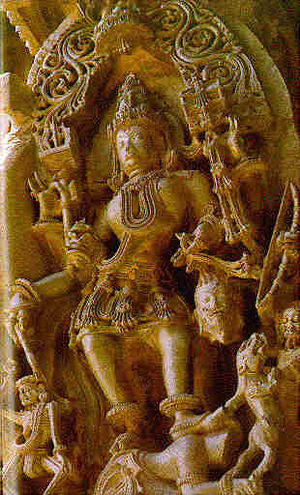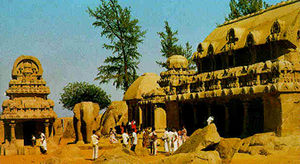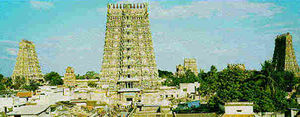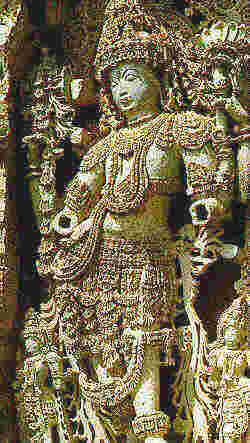Feudalism in post-Maurya times
By Shri Sudheer Birodkar
Mauryans had a centralized agriculture system with state owned large holdings, tribesmen working there for a salary and tax collected through state employed tax collectors. In post-Mauryan times, the jurisdiction of tax collection was no longer limited to the tiny isolated Janapadas due to the geographical spreading of farmlands over vast areas. With the collapse of the empire and the disintegration of this centralized apparatus, this task became increasingly difficult. This created the necessity for an intermediate class between the tillers of the widespread farmlands and the sovereign monarch. The extension of farmlands on almost limitless scale along with the corresponding absence of a centralized tax collecting apparatus was one of the most important reasons for the emergence of intermediaries and the rise of feudalism.
Disappearance of the Shreni Guilds[edit]
The expansion of the physical dimensions of the agrarian economy required the large scale supply of various commodities to the countryside. The apparatus of the Arthashastra type with its heavy tolls at every Janapada frontier now became a hindrance for the essential commodity movements due to large scale trade handled by private traders spread across expanding territories. The only way to satisfy the village demand was for the producer-artisans to move out of the centralized Shreni guilds and spread out into the countryside. With the strengthening of this tendency, the urban based centralized production units of the Mauryan period began to disintegrate along with the cohesive Shreni guilds.
The Rise of the Self-Sufficient Village Economy[edit]
The individual producers resulting from this falling mode of production settled in the scattered villages throughout the countryside. In the absence of good means of communications, the village now began to get the characteristic of being itself self-sufficient closed economic unit which produced all its required commodities internally without any exchange or trade. While trade did exist it was a much smaller and irregular scale than it was in the Mauryan times. Thus while in Europe the coming of feudal relations in the middle ages saw the rise of craftsmen-guilds, in India the rise of feudal relations was marked by the disintegration of the Shreni guilds.
Rise of a Class of Hereditary Revenue Collectors - the Feudal Lords[edit]
The shifting of economic activity was accompanied by the shifting of political power to the rising class of village feudatory revenue collectors who stood one above the other in a hierarchy in place of the salaried bureaucrats who collected revenue for the Mauryan State. Thus the position of a revenue collector changed from being that of a salaried employee of the king to that of a petty chieftain himself. Such hereditary revenue collectors were called "Samant". They also maintained a fighting force which could be called upon by the king when needed to defend or attack other kingdoms. The Samants were the feudal nobility.
Role of Temples in Revenue Collection[edit]
When such revenue collectors were to be appointed for the first time, the opposition of the tax paying tillers was smothered by making religious institutions like temples, Ashrams, Viharas, Chaityas, etc., perform the function of collecting revenue. Along with the right to collect revenue there was an obligation to pass on a part of the proceeds to the king who had given the land grant. Only in rare cases was the obligation to pass on part of the revenue to the donor-king was waived. Thus these temples and monasteries served both as the institutional and ideological arms for establishing this new mode of revenue collection. Thus the administrative costs of overcoming the opposition to this new revenue system was also reduced by making ecclesiastical institutions as intermediaries.
Brahmadeya, Devadana and Agrahara Land Grants[edit]
The land grants given to religious institutions were called Brahmadeya, (i.e. donated to Brahmins) Devadana (donated to Gods) and Agrahara (Settlement - of priests). These lands donated to the temples and monasteries apart from being used as normal tenancy also carried a right vested with the temple authorities to call for unpaid labour (called Vishti) as a religious service to the temple from the tillers on the donated land. This unpaid labour, became an important method of enrichment of the intermediary revenue collectors, which the temples were, apart from having the rights of revenue collection.
Right to carry arms for the Nobility 'Samants'[edit]
The feudal lords and the petty local chieftains were given right to bear arms for the purpose of revenue collection. These armed feudal lords could be called upon by the king to render military service to quell a rebellion or defend the kingdom from attack or to launch an attack on neighboring kingdoms.
The armed retinue of every feudal revenue collector-administrator was maintained out of the revenue collected locally. Thus the local feudal lord was the paymaster of this armed soldierly, and not the king whose kingdom they might be called on to defend. This undermined the power of the king and we hear of rebellious nobles in this period which was unthinkable during the centralized administration of Mauryan times.
Ultimately the maintenance of armed guards and the obligation to render military service became the qualification for making grants of land with revenue collection rights. These grants were made in recognition of valor displayed by the various feudal lords in the battles in which the particular kingdom was involved. The Jagirdari, Subahdari and Inamdari grants of the Muslim period which came later were also of this type. But the feudal relations were established in the Post-Maurya period, much before the coming of the Muslims.
The King was at the mercy of his Noblemen[edit]
The political consequences of this type of dependence of the king on the feudal lords in military matters often turned out to be unfortunate for those kings who did not have sufficient control over their vassals and their private armies of retainers. Many a times the vassals did not pass on the revenue collected to their king leading to a perpetual struggle between the king and the feudal lords under him. Often the feudal lords would switch loyalties from one king to another whenever circumstances favored.
The feudal system as a whole was characterized by the diffusion of executive authority in the hands of innumerable petty chieftains vastly reducing the absolute power of the king.
References[edit]
- Sudheer Birodkar, "A Hindu History: A Search for our Present History". Reprinted with permission.





